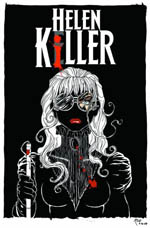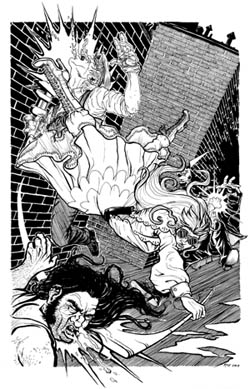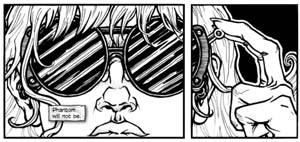 Written by Andrew Kreisberg
Written by Andrew Kreisberg
Art by Matthew JLD Rice
32 pages, black and white
Published by Arcana Comics
There are some book concepts that you hear and the idea instantly grabs you; others end up being a strong turn-off that keeps you away from the final product. What you don’t really see much of, though, are those books where the concept is so out there that your initial reaction is, "I absolutely have to see this to believe it." That’s how I felt about Arcana Comics’s Helen Killer, casting the famous blind-and-deaf woman in a whole new light: professional assassin. And you know what? I’m really glad I took a look.
 Until almost the age of seven, Helen Keller existed in a blank, silent world of her own, calling herself "Phantom." Then Anne Sullivan came into her life and taught Helen how to finally communicate with and understand the rest of the world. Now, twenty-one years old and attending university at Harvard, a whole new chapter is opening into her life. Alexander Graham Bell has created a pair of glasses that allows her to see—but also unleashes her buried "Phantom" personality. With lightning-fast reflexes and deadly fighting skills, the Secret Service has a special task for her: protect President William McKinley from a planned assassination attempt.
Until almost the age of seven, Helen Keller existed in a blank, silent world of her own, calling herself "Phantom." Then Anne Sullivan came into her life and taught Helen how to finally communicate with and understand the rest of the world. Now, twenty-one years old and attending university at Harvard, a whole new chapter is opening into her life. Alexander Graham Bell has created a pair of glasses that allows her to see—but also unleashes her buried "Phantom" personality. With lightning-fast reflexes and deadly fighting skills, the Secret Service has a special task for her: protect President William McKinley from a planned assassination attempt.
I freely admit that my expectations for Helen Killer #1 were rather low, but I won’t deny that my curiosity was really eating away at me. Helen Keller, stone-cold killer? It’s funny and silly and you can’t help but think that such a book would end up being rather painfully bad. What I found instead, though, was a thoroughly enjoyable comic. Don’t get me wrong, the basic idea is a little silly, but Andrew Kreisberg really manages to sell the concept in a serious manner. I think it helps in no small part because he makes it feel organic; he references Helen’s childhood "Phantom" side (which was real) and treats it as a distinct personality, and then has its resurfacing specifically through Bell’s device. Don’t get me wrong, the basic idea is still a little goofy, but it has an internal logic that stays consistent. It’s also a nice touch that with the exception of the potential love interest, all of the characters of Helen Killer are real. Sure, one could laugh at a book like this trying to stay true to history, but the less deviation there is, the more impressed I am with how little was changed in order for the story to work.
 Matthew JLD Rice’s art for Helen Killer seems strangely old-fashioned; I’m not entirely sure if this was a style he developed for Helen Killer or if it’s how he normally draws, but either way it’s a smart fit. I’m not just talking about the ruffled dresses and elegant waistcoats that Rice draws here, but the overall sense of the art. It feels very staid, very formal. When Helen lets Phantom take over, then, it’s all the more surprising to see her suddenly leaping across alleyways and striking people with her cane. The visuals for the book have some nice touches along the way, too; the way Rice draws Helen’s dark glasses with their diagonal light reflections looks creepy and intriguing at the same time, and Blaylock’s perpetual befuddlement is more than a little endearing.
Matthew JLD Rice’s art for Helen Killer seems strangely old-fashioned; I’m not entirely sure if this was a style he developed for Helen Killer or if it’s how he normally draws, but either way it’s a smart fit. I’m not just talking about the ruffled dresses and elegant waistcoats that Rice draws here, but the overall sense of the art. It feels very staid, very formal. When Helen lets Phantom take over, then, it’s all the more surprising to see her suddenly leaping across alleyways and striking people with her cane. The visuals for the book have some nice touches along the way, too; the way Rice draws Helen’s dark glasses with their diagonal light reflections looks creepy and intriguing at the same time, and Blaylock’s perpetual befuddlement is more than a little endearing.
For a book that seemed like a massive joke, I have to say that I’m impressed. It’s a fun, smart book that takes an off-the-wall premise and makes it work. If the rest of the mini-series is as strong as its first issue, well, I think Kreisberg and Rice will be making "Alias meets The Miracle Worker" jokes all the way to the bank. In the end, it’s more enjoyable than you’d have ever imagined it to be.
